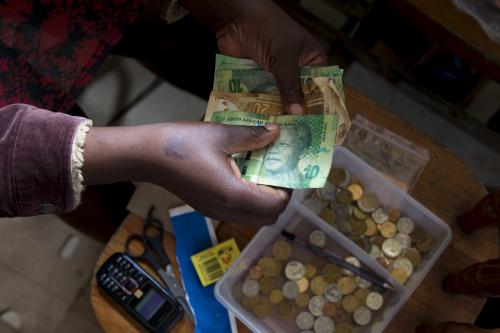Government debt and borrowing costs for sub-Saharan African countries have been rising in recent years. In several countries, external debt servicing costs—the money needed to cover the interest and principal on debt—are now at their highest level since 2003. The rising debt servicing costs are already reducing funding for economic development; Kenya cut its development budget for the upcoming year and Zambia suspended development of projects below 80 percent completion. These cutbacks come at a time when the region is falling short of the needed investment rates of 30 percent of GDP or higher over a sustained period to achieve economic transformation. The rising debt levels and debt servicing cost against the backdrop of growing domestic financing needs is a reminder that the challenge of sustainable development financing across the region has not yet been addressed.
In a recent policy brief, Mobilization of tax revenues: state of play and policy options, we analyze tax revenue collection in sub-Saharan Africa, and explore its potential to bridge part of the continent’s financing shortfall. In what follows, we highlight some key takeaways from our research.
Tax revenues have been increasing but they remain low
As Figure 1 shows, the region has made progress in raising non-resource tax revenues over the past two decades, and social contributions from roughly 11 percent in the early 2000s to around 15 percent in 2015, excluding social contributions (averages based on an unbalanced panel dataset). Crucial to improving revenue collection were reforms such as the introduction of value-added taxes, programs to improve taxpayer services, and rollout of electronic tax filing systems. Despite these efforts, tax revenues remain low at 15 percent of GDP, significantly below the OECD average of 24 percent.
Figure 1: Regional non-resource taxes 2000-20015 as percent of GDP
Tax capacity and revenue collection efficiency have improved since 2000
To understand the recent improvements to the region’s revenue collection and the restraining factors remaining we study two fundamental drivers of tax revenues mobilization in Africa over the past two decades: taxation capacity and efficiency in tax revenue mobilization. The tax capacity of a country defines the optimum tax revenues as percent of GDP that it can mobilize given the structure of its economy. Besides tax capacity, inefficiency in revenue mobilization due to poor governance, leakages, or weak enforcement could cause revenues to fall short of countries’ tax capacities.
As Figure 2 below shows, sub-Saharan Africa has the lowest tax capacity across regions at 20 percent of GDP. The region does better on tax collection efficiency, which improved to 0.78 in the most recent year from around 0.70 (a score of 1 is best performance while 0 is worst) in the early 2000s. The region’s low tax capacity is primarily attributable to its low level of economic development, a large share of agriculture in economic activity, and the large size of its shadow economy.
Figure 2: Tax capacity and tax collection efficiency by region (most recent year)
Strengthening governance in revenue collection can mobilize up to $110 billion over the next five years
Given that the tax capacity is largely determined by structural factors, boosting it should remain a medium- to long-term objective. In contrast, closing the gap between current tax revenues and tax capacity is attainable in the near term through policies to strengthen governance in revenue collection. Despite increases in tax collection efforts across sub-Saharan Africa, there remains a significant gap—roughly 4 percentage point of GDP on average—between the region’s current tax revenue and its tax capacity, owed to inefficiencies in revenue collection.
The region lags on both corruption and democratic accountability indicators, with the lowest average scores in the world.
Figure 3: Average governance scores by region
We estimate the revenue gap could close if the region’s corruption and democratic accountability scores move up to the global median, still below those of the OECD countries. Successfully closing the gap could raise an additional $110 billion over the next five years. Nigeria has the largest estimated tax gap of $60 billion accounting for almost half of the region’s total, due to the size of its economy and its low tax revenues. South Africa and Angola are second and third with nominal gaps of $10 billion and $8 billion respectively.
Strengthening public financial management including enhancing efficiency and equity of public spending can also help. Citizens are more likely to comply with tax collection when they trust that their tax revenues are well managed.
Lastly, technology can play a crucial role in supporting tax mobilization efforts. Already, several countries including Ethiopia, Liberia, and Rwanda have implemented programs to adopt electronic platforms for reporting or collecting taxes. This can help improve efficiency by lowering compliance costs, reducing leakages, and streamlining the tax collection process. Further, it can help raise tax capacity through digitization efforts that formalize informal businesses and expand the tax base. This can include interventions to increase access to financial services, provide business support services and training for entrepreneurs.
With the external financing environment likely to deteriorate further as global interest rates and debt levels rise, and as commitments to development assistance dwindle, raising domestic resources to finance sustainable development agendas is more imperative than ever.
The Brookings Institution is committed to quality, independence, and impact.
We are supported by a diverse array of funders. In line with our values and policies, each Brookings publication represents the sole views of its author(s).










Commentary
Better tax collection can help tackle rising debt in Africa and the challenge of development finance
October 22, 2018